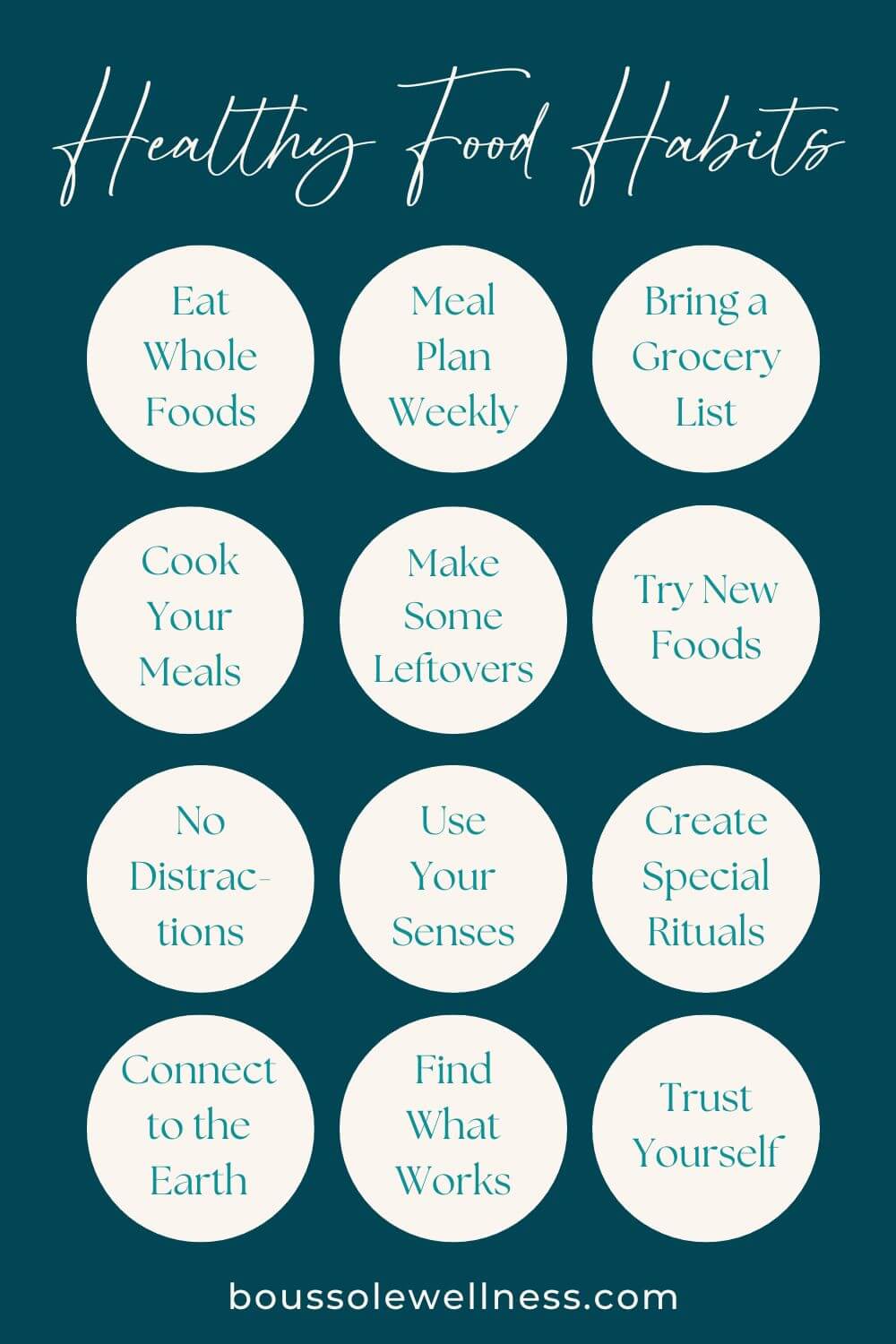Boussole
Wellness
Blog
Boussole Wellness
Blog
Let’s navigate the journey from burnout to blissful balance together!
Learn how I turned exhaustion into empowerment, and am now living a life full of energy and love.

Mastering Your Mindset
When people think of wellness, they think of diet and exercise. We hear about both often enough that we know they’re important if we want to be healthy and feel good.
There is also a plethora of information out there if you look.
For eating healthy, you can find diets for losing weight, bulking up, improving your gut health, anti-inflammation, or whatever it is you want to improve, reduce, or eliminate.
I’ve kept things simple with a list of healthy habits to practise to make eating healthy easier for you and your family. Read the full blog article, or have a look at this diagram that outlines the essentials.

The same goes for exercise. There are so many different workouts available on Google if you take a look. Do HIIT (High Intensity Interval Training). Do steady state workouts. Lift weights. Practice yoga. Do mobility. There is a wealth of information on physical activity and exercise if you’re keen (bonus: many of them are free too!).
But for those who aren’t wanting to spend even more time online, my guideline is to keep it manageable, measurable, and easy. Check out this post for more information.
Healthy eating and daily movement are two of the six pillars in Burnout to Bliss. These six self-care pillars are essential if you want to build a solid foundation of healthy habits that will allow you to live a life you love. In this 12-week burnout recovery program, you will create a personalised self-care practice that works for you, your personality, and your lifestyle. Get started on your journey to bliss here.
Another pillar that is equally important but that doesn’t get as much recognition is mastering your mindset.
When I was a teacher, growth mindset was something that you heard about often. I had posters in my room and I certainly encouraged my students to have a growth mindset (if you’re not familiar with Carol Dweck’s work, see the diagram below).

What’s ironic is that while I learned all about growth mindset and actively encouraged students to have a growth mindset, I myself seemed to have a fixed mindset. As a perfectionist, I took feedback very personally and blamed myself for any mistakes. I was ashamed of failing and avoided challenges if I didn’t think I could succeed.
When I started my certification for coaching, both programs I trained in talked about mindset A LOT. It began to dawn on me that maybe my mindset was what was holding me back from achieving what I really wanted. So I began to dig deeper.
What exactly is mindset and why bother mastering it?
Your mindset is your beliefs and opinions about the way that the world works.
It shapes the way you view the world and that shapes how and what you think about.
It determines how you feel about the present moment, about your past, and about your future.
Your mindset also determines what actions you take and don’t take, and it impacts how you view others.
So much of your potential is either limited or expanded because of your mindset.
With the right attitude and consistent action, you can change anything about your life.
You have it within you to change your health, your relationship, your career, all for the better, if that is what you truly want.
Being intentional about changing your mindset inspires you to take action.
And without action, nothing changes.
If you asked a friend to tell you what colour lenses you had in your sunglasses, what would they say? Be honest with yourself!
Rose coloured because you’re usually positive and upbeat?
Dark grey because you’re often negative and pessimistic?
First, you need to understand the concept of neuroplasticity: the brain’s ability to change and adapt.
Throughout your life, you go through many experiences, both positive and negative, which contribute to your thinking and influence your future thoughts and behaviour patterns. These encounters create new neural pathways in your brain.
The ability of your brain to reorganise itself in response to experiences and learning is neuroplasticity.
From birth to your mid-twenties, you can rewire your brain passively just by information exposure—children create new neural pathways just by experiencing new environments!
As an adult, you need to actively learn new information to rewire your neural pathways.
You can stimulate your brain by:
Reading
Creating art
Playing an instrument
Learning a new language
Travelling and exploring new places (my favourite!)
Because of your brain’s ability to rewire itself, you have the capacity to learn new skills, acquire new knowledge, and develop new abilities throughout your life.
When you adopt a growth mindset, you are more likely to learn new things, take on new challenges, and persist when faced with obstacles. A growth mindset creates an environment that nurtures and supports neuroplasticity, stimulating new neural pathways to form as the brain adapts to new learning.
So, how do you change your mindset?
Your brain’s neuroplasticity means that it’s flexible and adaptable. It can be trained to focus on what you want it to focus on. The process itself isn’t complicated, but it does require persistence and discipline to stick to it.
Mastering your mindset isn’t something that happens overnight. It’s something that you need to work on every day to make it an ingrained habit. Don’t worry, if creating new habits has been a challenge in the past, in Burnout to Bliss I’ll share my simple, proven 4-step process for making them stick for good!
Your brain is always trying to help you by filtering information about the world for you. The reticular activating system (RAS) is the filter that determines what information gets into your conscious mind. Your RAS helps with information overload by only letting in what you want to focus on, what is important to you.
You can change what the filter focuses on with a two-step process.
The first step is to catch your negative mindset. For example, if you’re thoughts are spiralling downward because you’re feeling overwhelmed by your never-ending to-do list, tell yourself to STOP. Take a deep breath.
Then swap it for a positive reframe: I GET to spend time with my children. I WILL ask my partner for help with the chores.
Be intentional about what you want the filter to notice (your mind is trying to help you!).
Your mindset and your filter are interconnected- your thoughts determine what your filter lets in.
When your thoughts (and your mindset) skew toward the negative, your filter lets in the negative because that is what you’re focusing on.
The more you keep thinking about your annoying colleague Roger screeching into work late while expecting you to cover the slack, the more frustrated you get every time he only partially finishes a task, clocks out early, and blames someone else for something you know he did.
But if you start thinking about that new project you're excited to lead, the more you see how your team is pulling together, bringing innovative ideas to the table that are going to bring the project in early and under budget. (And the more excited you get about the project the less Roger and his antics annoy you.)
To prove that you can train your mind to work for you, I challenge you to go on a heart scavenger hunt in nature.
Tell yourself you’re going to find hearts on your next walk. As you’re walking, look around you.
How many hearts can you find?
Leaves, rocks, clouds... they’re there.
Be intentional. Do this every day for a week. You’re training your brain to refocus your filter.
Reward your brain for finding hearts.
Your brain’s filter is now focused on looking for hearts in your environment. They were always there, but you didn’t see them because your brain wasn’t looking for them.
You can reprogram your brain by changing your filter’s focus.
Catch your default negative thoughts and substitute them with something positive.
This thought substitution is called Cognitive Bias Modification.
Be actively engaged in training your brain to work for you—let it inspire you to take action on what you desire to change!
The thoughts that you think dictate the world that you see, the way that you feel, and the actions you take.
Get serious and be intentional about having a more optimistic attitude. Tell yourself "I can do this!".
A positive mindset empowers you to take action on your goals.
Training your mindset intentionally and consistently will support you in enjoying more bliss every day.

Mastering Your Mindset
When people think of wellness, they think of diet and exercise. We hear about both often enough that we know they’re important if we want to be healthy and feel good.
There is also a plethora of information out there if you look.
For eating healthy, you can find diets for losing weight, bulking up, improving your gut health, anti-inflammation, or whatever it is you want to improve, reduce, or eliminate.
I’ve kept things simple with a list of healthy habits to practise to make eating healthy easier for you and your family. Read the full blog article, or have a look at this diagram that outlines the essentials.

The same goes for exercise. There are so many different workouts available on Google if you take a look. Do HIIT (High Intensity Interval Training). Do steady state workouts. Lift weights. Practice yoga. Do mobility. There is a wealth of information on physical activity and exercise if you’re keen (bonus: many of them are free too!).
But for those who aren’t wanting to spend even more time online, my guideline is to keep it manageable, measurable, and easy. Check out this post for more information.
Healthy eating and daily movement are two of the six pillars in Burnout to Bliss. These six self-care pillars are essential if you want to build a solid foundation of healthy habits that will allow you to live a life you love. In this 12-week burnout recovery program, you will create a personalised self-care practice that works for you, your personality, and your lifestyle. Get started on your journey to bliss here.
Another pillar that is equally important but that doesn’t get as much recognition is mastering your mindset.
When I was a teacher, growth mindset was something that you heard about often. I had posters in my room and I certainly encouraged my students to have a growth mindset (if you’re not familiar with Carol Dweck’s work, see the diagram below).

What’s ironic is that while I learned all about growth mindset and actively encouraged students to have a growth mindset, I myself seemed to have a fixed mindset. As a perfectionist, I took feedback very personally and blamed myself for any mistakes. I was ashamed of failing and avoided challenges if I didn’t think I could succeed.
When I started my certification for coaching, both programs I trained in talked about mindset A LOT. It began to dawn on me that maybe my mindset was what was holding me back from achieving what I really wanted. So I began to dig deeper.
What exactly is mindset and why bother mastering it?
Your mindset is your beliefs and opinions about the way that the world works.
It shapes the way you view the world and that shapes how and what you think about.
It determines how you feel about the present moment, about your past, and about your future.
Your mindset also determines what actions you take and don’t take, and it impacts how you view others.
So much of your potential is either limited or expanded because of your mindset.
With the right attitude and consistent action, you can change anything about your life.
You have it within you to change your health, your relationship, your career, all for the better, if that is what you truly want.
Being intentional about changing your mindset inspires you to take action.
And without action, nothing changes.
If you asked a friend to tell you what colour lenses you had in your sunglasses, what would they say? Be honest with yourself!
Rose coloured because you’re usually positive and upbeat?
Dark grey because you’re often negative and pessimistic?
First, you need to understand the concept of neuroplasticity: the brain’s ability to change and adapt.
Throughout your life, you go through many experiences, both positive and negative, which contribute to your thinking and influence your future thoughts and behaviour patterns. These encounters create new neural pathways in your brain.
The ability of your brain to reorganise itself in response to experiences and learning is neuroplasticity.
From birth to your mid-twenties, you can rewire your brain passively just by information exposure—children create new neural pathways just by experiencing new environments!
As an adult, you need to actively learn new information to rewire your neural pathways.
You can stimulate your brain by:
Reading
Creating art
Playing an instrument
Learning a new language
Travelling and exploring new places (my favourite!)
Because of your brain’s ability to rewire itself, you have the capacity to learn new skills, acquire new knowledge, and develop new abilities throughout your life.
When you adopt a growth mindset, you are more likely to learn new things, take on new challenges, and persist when faced with obstacles. A growth mindset creates an environment that nurtures and supports neuroplasticity, stimulating new neural pathways to form as the brain adapts to new learning.
So, how do you change your mindset?
Your brain’s neuroplasticity means that it’s flexible and adaptable. It can be trained to focus on what you want it to focus on. The process itself isn’t complicated, but it does require persistence and discipline to stick to it.
Mastering your mindset isn’t something that happens overnight. It’s something that you need to work on every day to make it an ingrained habit. Don’t worry, if creating new habits has been a challenge in the past, in Burnout to Bliss I’ll share my simple, proven 4-step process for making them stick for good!
Your brain is always trying to help you by filtering information about the world for you. The reticular activating system (RAS) is the filter that determines what information gets into your conscious mind. Your RAS helps with information overload by only letting in what you want to focus on, what is important to you.
You can change what the filter focuses on with a two-step process.
The first step is to catch your negative mindset. For example, if you’re thoughts are spiralling downward because you’re feeling overwhelmed by your never-ending to-do list, tell yourself to STOP. Take a deep breath.
Then swap it for a positive reframe: I GET to spend time with my children. I WILL ask my partner for help with the chores.
Be intentional about what you want the filter to notice (your mind is trying to help you!).
Your mindset and your filter are interconnected- your thoughts determine what your filter lets in.
When your thoughts (and your mindset) skew toward the negative, your filter lets in the negative because that is what you’re focusing on.
The more you keep thinking about your annoying colleague Roger screeching into work late while expecting you to cover the slack, the more frustrated you get every time he only partially finishes a task, clocks out early, and blames someone else for something you know he did.
But if you start thinking about that new project you're excited to lead, the more you see how your team is pulling together, bringing innovative ideas to the table that are going to bring the project in early and under budget. (And the more excited you get about the project the less Roger and his antics annoy you.)
To prove that you can train your mind to work for you, I challenge you to go on a heart scavenger hunt in nature.
Tell yourself you’re going to find hearts on your next walk. As you’re walking, look around you.
How many hearts can you find?
Leaves, rocks, clouds... they’re there.
Be intentional. Do this every day for a week. You’re training your brain to refocus your filter.
Reward your brain for finding hearts.
Your brain’s filter is now focused on looking for hearts in your environment. They were always there, but you didn’t see them because your brain wasn’t looking for them.
You can reprogram your brain by changing your filter’s focus.
Catch your default negative thoughts and substitute them with something positive.
This thought substitution is called Cognitive Bias Modification.
Be actively engaged in training your brain to work for you—let it inspire you to take action on what you desire to change!
The thoughts that you think dictate the world that you see, the way that you feel, and the actions you take.
Get serious and be intentional about having a more optimistic attitude. Tell yourself "I can do this!".
A positive mindset empowers you to take action on your goals.
Training your mindset intentionally and consistently will support you in enjoying more bliss every day.
“Keep good company, read good books, love good things, and cultivate soul and body as faithfully as you can.”
~ Louisa May Alcott
Connect
© Copyright 2026 Boussole Wellness Coaching | Helping women find more balance and feel more fulfilled!
Photography by Christina Louise Branding









